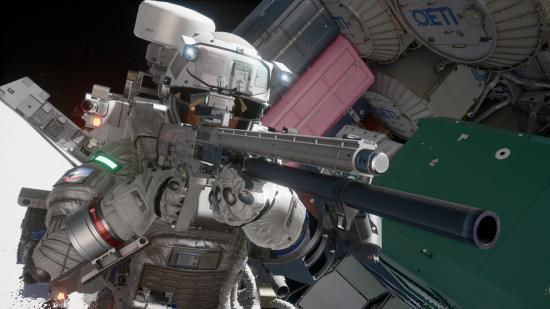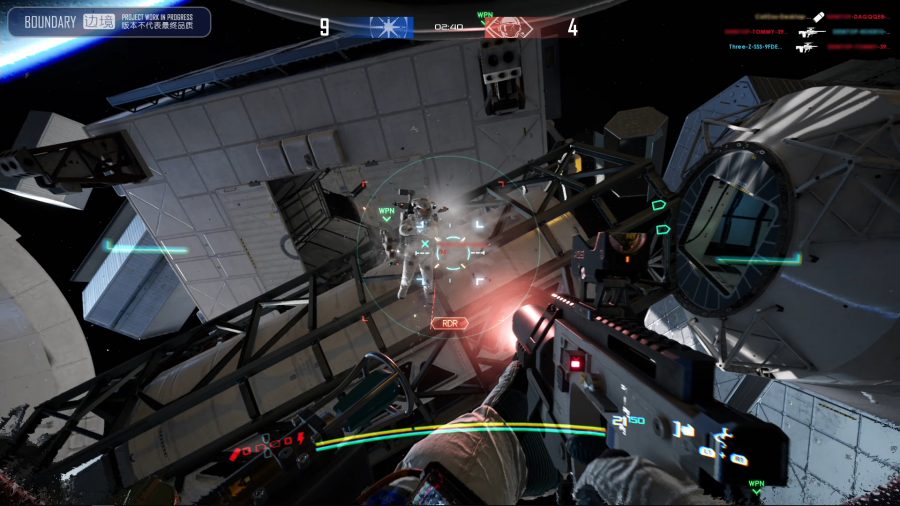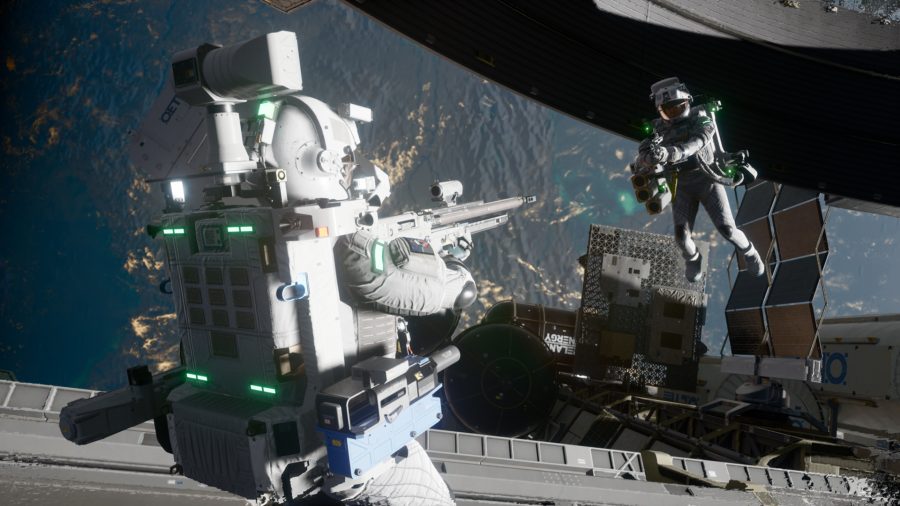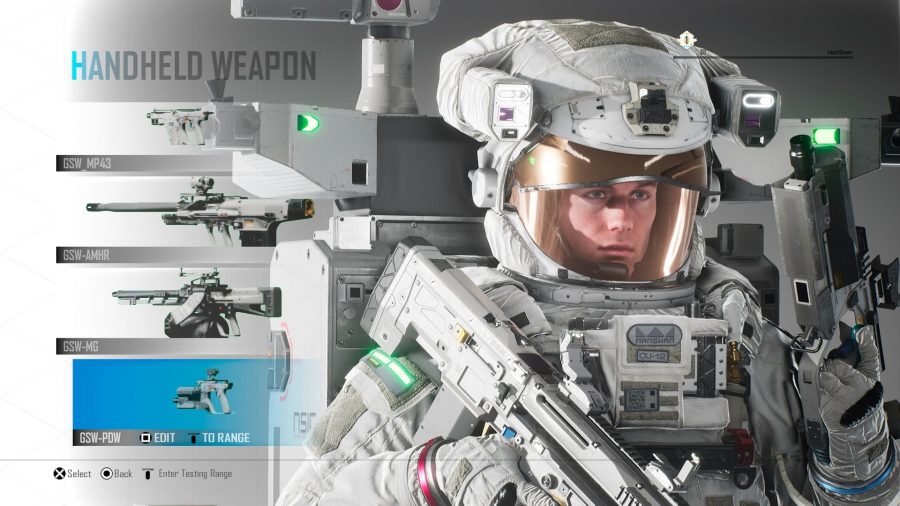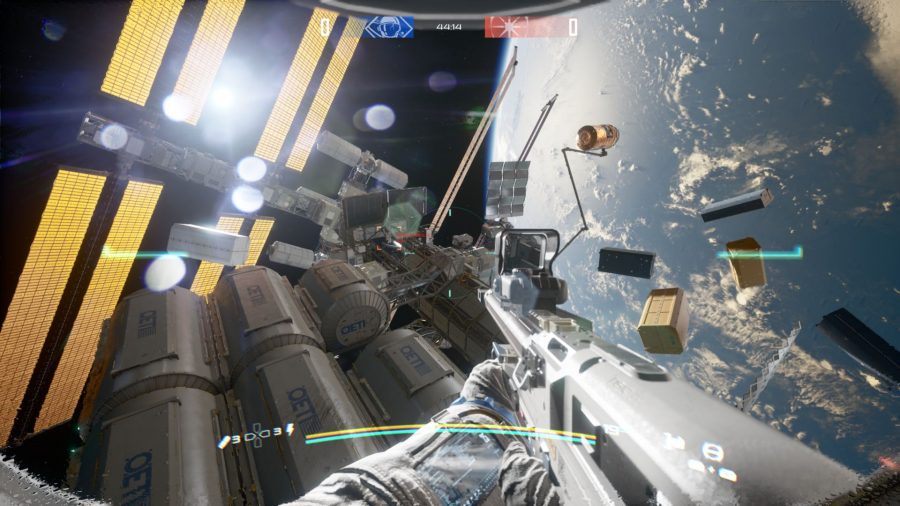From one look at its trailer, you could mistake Boundary for a highly polished Hollywood production. It’s full of slow-motion drama, there’s danger around every corner, and it has a cinematic sheen that echoes blockbuster sci-fi films such as Gravity and Interstellar. And yet – as you’ll soon realise once astronauts start aiming down gunsights – Boundary is a multiplayer tactical shooter.
Boundary takes place in a not-too-distant future where space is no longer the final frontier but the next battleground for the world’s militaries. Space suits are equipped with state-of-the-art weaponry with which players must contest a number of extraplanetary maps, including a solar farm, an orbital fuel station, and a field of floating space debris. Players choose their astronaut from six different classes, such as assaulters, snipers, and medics, and take part in 5v5 deathmatches.
For a 14-person indie team, developer Surgical Scalpels has set a high bar for Boundary. Some of the game’s disproportionate polish can be attributed to Frank Mingbo Li, Surgical Scalpels’ CEO and technical director, who has a wealth of industry experience.
“I know exactly how a particular game engine can have an impact on the game side of development,” Li says. “The engine drives your product and it’s the main reason why triple-A studios have a whole R&D department dedicated to managing the engine side of things.”

Li knows his way around Unreal Engine, having previously worked on UE4 as a physics programmer. He has also worked with studios like Rare and Codemasters before joining Surgical Scalpels. With his expertise, and help from Epic, the small studio is confident of hitting its goals with Boundary.
“Our game director has tons of experience of the Unreal Developer Kit,” Li says. “So when we met and started Boundary, UE4 seemed like the obvious choice for us primarily because of the experience we had on it from other roles. Unreal Engine has the support in place that we need, and Epic does a great job taking over the triple-A game studio R&D department role. So even as a small indie developer, we benefit from resources that resemble those of a triple-A studio’s game team.”
Unreal Engine also features a number of in-built features that Surgical Scalpels has found useful. Its Blueprint tool has been celebrated by developers throughout the Making it in Unreal series, and Li also commends it for helping the team bring their ideas to life without the hassle of learning a whole coding language. But for Li, Unreal’s openness to third-party software was its key virtue when it came to certain technical challenges.
“The way in which game developers work is not unlike a kid in a candy store,” Li says. “There’s so much that they explore and play. In instances where we break it, or need to customise tools to fit the game features, developers can dig into an engine to figure out the best solution on how to implement the tech.
“For example, UE4 doesn’t support double-side ray-tracing, which is very useful to develop a feature like bullets penetrating objects of different sizes. Of course, you can do it with two rays, but a single ray-tracing with double side enabled is the natural way to handle it. So we found the code, checked the PhysX document, and implemented it ourselves. UE4 is a general engine suitable for most games, and if you need to develop something it cannot do, you are still able to get your hands dirty and play around with it.”
So open-source software has allowed Surgical Scalpels to clear certain technical hurdles in developing Boundary, but the challenges in making a tactical FPS in zero gravity go way beyond the technical.
“Character movement was the very first development challenge we faced, because of the vertical and horizontal plane and zero-gravity environment,” Li says. “Because Astronauts use an EVA [jetpack] in the game to get around, they don’t fly like a vehicle or jet fighter on a level plane. You still have a horizontal plane to keep during combat because of the human element of the design.”
For the most part, humans aren’t the most agile creatures on the ground, let alone in zero-gravity. The ability to move quickly and aim precisely is vital in FPS games, and Surgical Scalpels has had to work out a number of ways for players to move around in addition to the jetpack.
“The tether system is something we implemented after watching various NASA spacewalks,” Li says, referring to the grapple with which players can pull themselves rapidly towards any attachable surface. “We wanted a faster, more immediate system of moving along floating structures.” You can briefly see the tether in action during Boundary’s teaser trailer. “This is so that players can make more use of the structures and can fight on them, not just around them. Powered jetpacks will propel players around the maps so they’ll have to adapt to powering their direction.”
An FPS in zero-gravity has an entirely different set of rules, requiring players to think and act in a unique way. You’ll face hazards from every direction, and the environment will bring new challenges and create opportunities for new gameplay styles that shooter fans haven’t seen before.
“This isn’t like Call of Duty, where unless you are using structures to get above your opponent, you’re going to need to have your head on a swivel,” Li says. “You have to fight like a jet fighter pilot. This means keeping an eye on your radar, but also looking all around you for other visible threats.”
Loadout design is a key element of many modern multiplayer shooters, and here again, the extraplanetary setting affords Surgical Scalpels the chance to break new ground. Boundary’s guns have a modular system enabling players to change a gun’s scopes, grips, barrels, magazines, and stocks – nothing new here – but also to load their magazine with different rounds in a specific order.
“A weapon can be configured to fire two armour penetrating [AP] rounds, one after another, to pierce the outer protective layer of spacesuits and EVAs. Players could then inflict further damage by following their initial burst with high-explosive [HE] round, and finish them off with an electromagnetic pulse [EMP] round.” You could configure this sequence of ammunition to repeat – AP-AP/HE-EMP, AP-AP/HE-EMP – until the magazine is depleted.
Not all of Boundary’s weapon engineering have been worked out just yet, but Surgical Scalpels wants to do something interesting with the way they sound. The mystical art of ‘gunfeel’ is vital in an FPS and sound is no small part of it, from the small ka-plunk of a grenade hitting the floor to the ear-splitting crescendo of gunfire. But space, as everyone knows, is a vacuum, and the community is actually keen to see the effect of that accurately depicted in the game.
“Most FPS players are used to noisy shooters, but the vacuum of space and the spacesuit would theoretically subdue sound,” Li explains. “We need to have some sound, of course, but so far the feedback from the community is that they actually want a more muffled or subdued sound. So adapting to that may be quite interesting for them.”
Surgical Scalpels will show more of Boundary at Gamescom in August. In the meantime, you can keep an eye on the studio’s Twitter account for further updates. Boundary is set to launch on PlayStation 4 first, and while a release on PC and other consoles is yet to be confirmed, the studio is keen to make it happen. We’ll hear later in 2019 if it does – let’s all cross our fingers and toes in hope that this cinematic space-based shooter launches on the technology that made exploring space possible all those years ago.
Boundary is planned to release sometime in 2019. Unreal Engine 4 development is now free.
In this sponsored series, we’re looking at how game developers are taking advantage of Unreal Engine 4 to create a new generation of PC games. With thanks to Epic Games and Surgical Scalpels.
